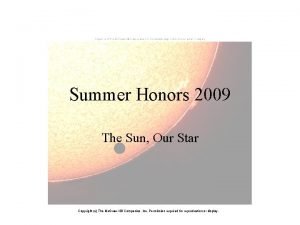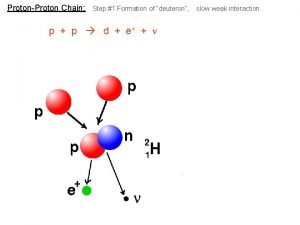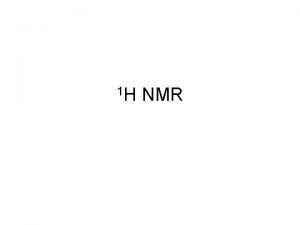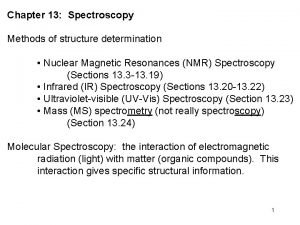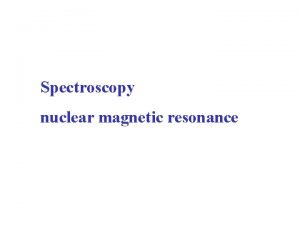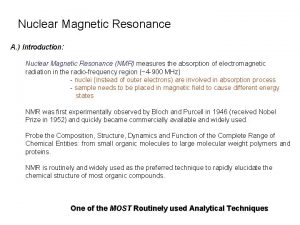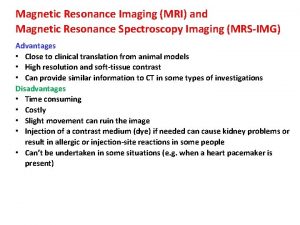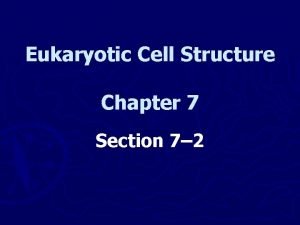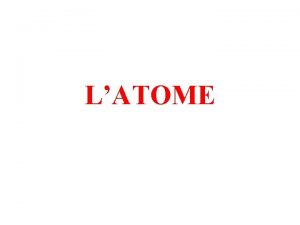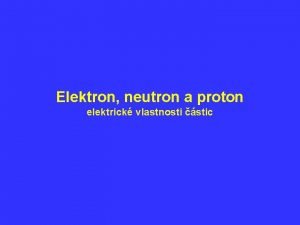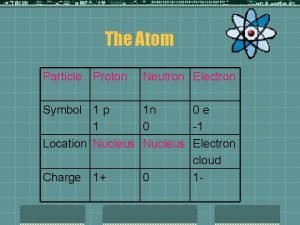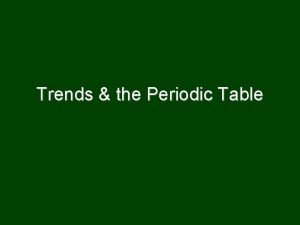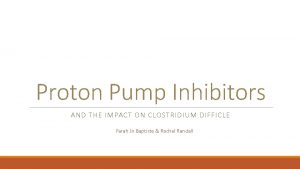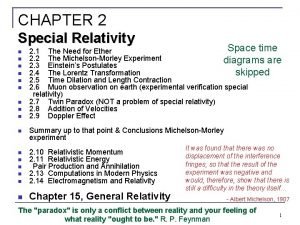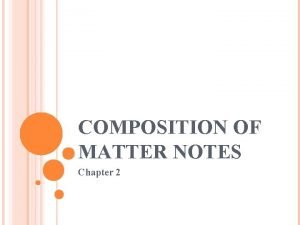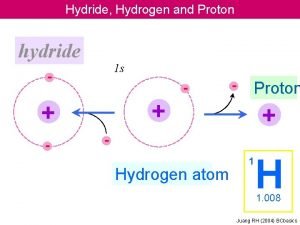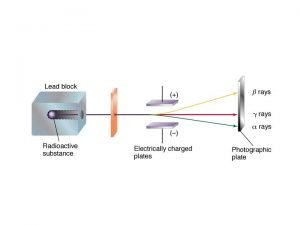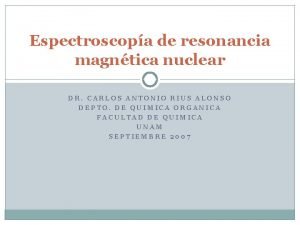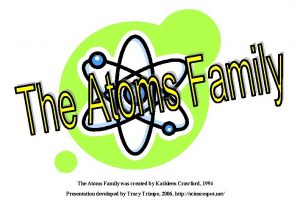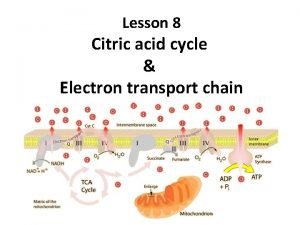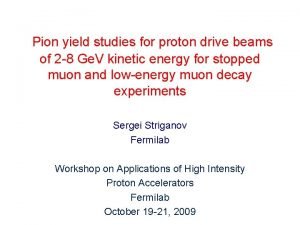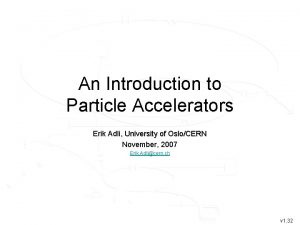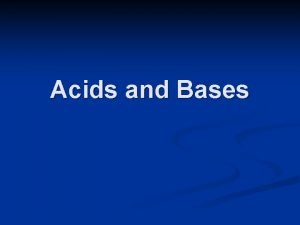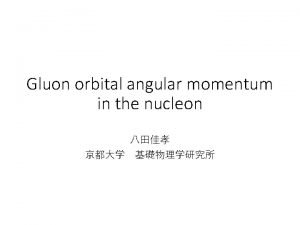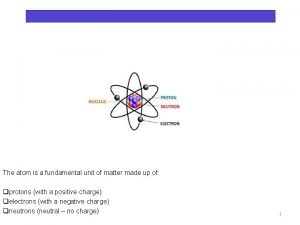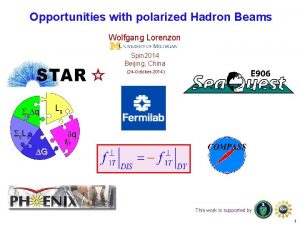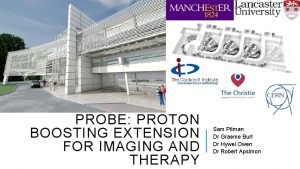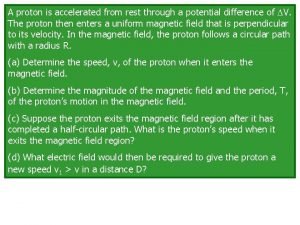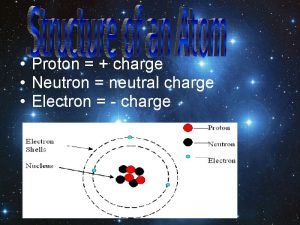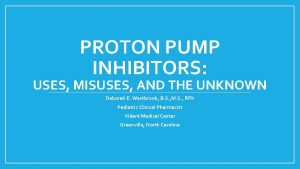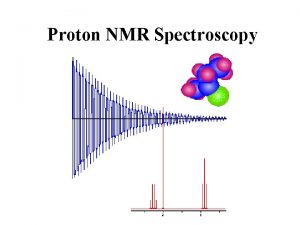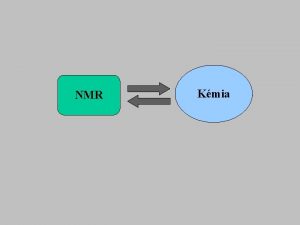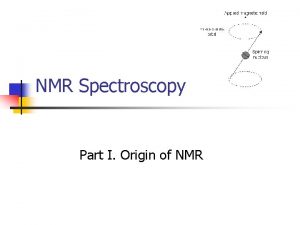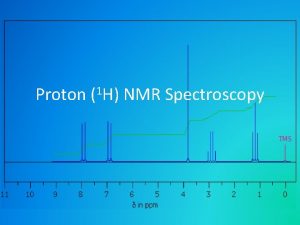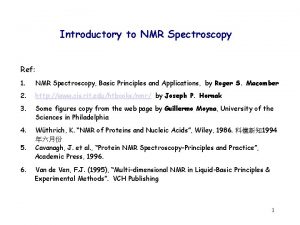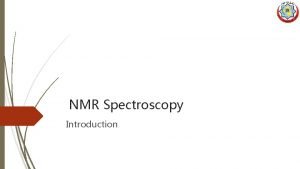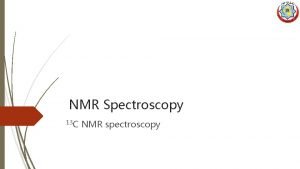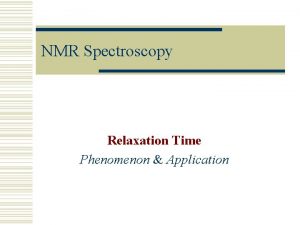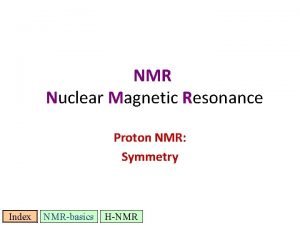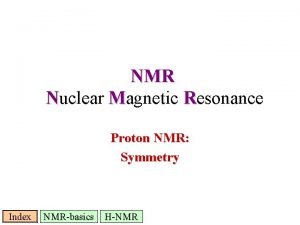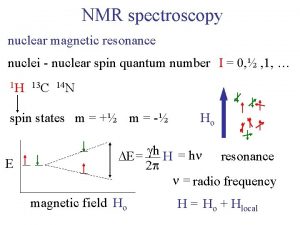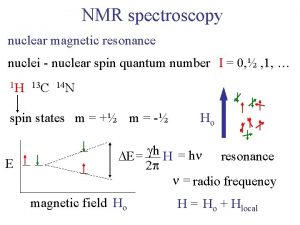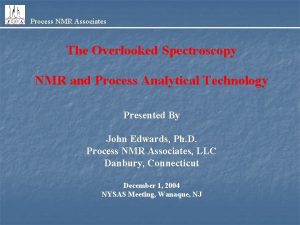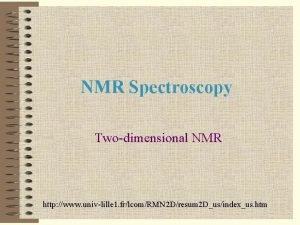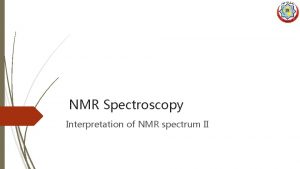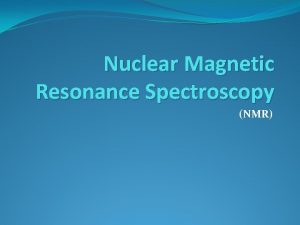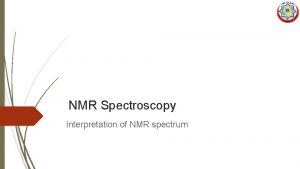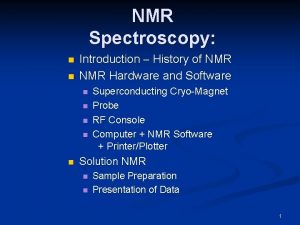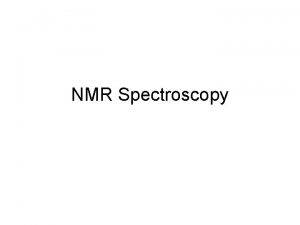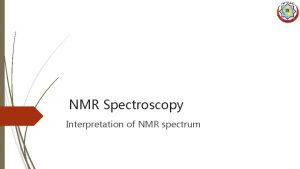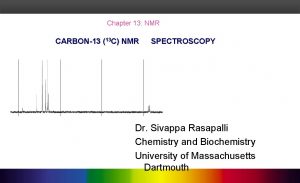Proton NMR Spectroscopy The NMR Phenomenon Most nuclei















































































- Slides: 79

Proton NMR Spectroscopy

The NMR Phenomenon • Most nuclei possess an intrinsic angular momentum, P. • Any spinning charged particle generates a magnetic field. P = [I(I+1)]1/2 h/2 p where I = spin quantum # I = 0, 1/2, 1, 3/2, 2, …

Which nuclei have a “spin”? • If mass # and atomic # are both even, I = 0 and the nucleus has no spin. e. g. Carbon-12, Oxygen-16 • For each nucleus with a spin, the # of allowed spin states can be quantized: • For a nucleus with I, there are 2 I + 1 allowed spin states. 1 H, 13 C, 19 F, 31 P all have I = 1/2 DE = g(h/2 p)Bo

Spin states split in the presence of B 0

When a nucleus aligned with a magnetic field, B 0, absorbs radiation frequency (Rf), it can change spin orientation to a higher energy spin state. By relaxing back to the parallel (+1/2) spin state, the nucleus is said to be in resonance. Hence, NMR

Presence of Magnetic Field

NMR instruments typically have a constant Rf and a variable B 0. A proton should absorb Rf of 60 MHz in a field of 14, 093 Gauss (1. 4093 T). Each unique probe nucleus (1 H perhaps) will come into resonance at a slightly different and a very small percentage of - the Rf. All protons come into resonance between 0 and 12/1, 000 (0 – 12 ppm) of the B 0.

• Nuclei aligned with the magnetic field are lower in energy than those aligned against the field • The nuclei aligned with the magnetic field can be flipped to align against it if the right amount of energy is added (DE) • The amount of energy required depends on the strength of the external magnetic field

Energy Difference ( E) Between Two Different Spin States of a Nucleus With I=1/2

What Does an NMR Spectrum Tell You? • # of chemically unique H’s in the molecule # of signals • The types of H’s that are present e. g. aromatic, vinyl, aldehyde … chemical shift • The number of each chemically unique H integration • The H’s proximity to eachother spin-spin splitting

Chemical Equivalence How many signals in 1 H NMR spectrum?

Number of Equivalent Protons

Homotopic H’s – Homotopic Hydrogens • Hydrogens are chemically equivalent or homotopic if replacing each one in turn by the same group would lead to an identical compound

Enantiotopic H’s • If replacement of each of two hydrogens by some group leads to enantiomers, those hydrogens are enantiotopic

Diastereotopic H’s • If replacement of each of two hydrogens by some group leads to diastereomers, the hydrogens are diastereotopic – Diastereotopic hydrogens have different chemical shifts and will give different signals

Vinyl Protons







Typical 1 H NMR Scale is 0 -10 ppm

The d Scale

Tetramethylsilane (TMS)

Chemical Shift Ranges, ppm


Diamagnetic Anisotropy Shielding and Deshielding

Deshielding in Alkenes

Shielding in Alkynes



Methyl t-butyl ether (MTBE)

Toluene at Higher Field Splitting patterns in aromatic groups can be confusing A monosubstituted aromatic ring can appear as an apparent singlet or a complex pattern of peaks

Integral Trace

Spin-Spin Splitting

The Doublet in 1 H NMR

Hb in 1, 1, 2 -Tribromoethane

The Triplet in 1 H NMR

Ha in 1, 1, 2 -Tribromoethane

1, 1, 2 -Tribromoethane

The Quartet in 1 HMR

1, 1 -Dichloroethane

Ethyl benzene

CH 3 CH 2 OCH 3

Equivalent Protons do not Couple

Pascal’s Triangle

Methyl Isopropyl Ketone

1 -Nitropropane

Differentiate using 1 H NMR

Coupling Constants (J values)

Para Nitrotoluene

Bromoethane

para-Methoxypropiophenone

Styrene

Ha splitting in Styrene “Tree” Diagram

In the system below, Hb is split by two different sets of hydrogens : Ha and Hc – Theortically Hb could be split into a triplet of quartets (12 peaks) but this complexity is rarely seen in aliphatic systems



C-13 NMR Spectroscopy

C-13 chemical shifts

Methyl Propanoate C-13 proton decoupled

Ethyl Acrylate; C-13 prediction

Ethyl Acrylate; C-13 NMR

Coupling in C-13 NMR



Butanone - Coupled and Decoupled

1, 2, 2 -Trichloropropane 1 H and 13 C NMR Spectra

Coupled C-13 NMR Spectrum









 Proton proton chain
Proton proton chain Nuclear fission
Nuclear fission Proton proton chain
Proton proton chain Benzoic acid nmr
Benzoic acid nmr Nmr active and inactive nuclei
Nmr active and inactive nuclei Chch3cl
Chch3cl Nmr spectroscopy
Nmr spectroscopy Factors affecting chemical shift
Factors affecting chemical shift Dept nmr spectroscopy
Dept nmr spectroscopy Advantages of nmr spectroscopy
Advantages of nmr spectroscopy Saclike structure that stores materials
Saclike structure that stores materials độ dài liên kết
độ dài liên kết Các môn thể thao bắt đầu bằng tiếng nhảy
Các môn thể thao bắt đầu bằng tiếng nhảy Sự nuôi và dạy con của hươu
Sự nuôi và dạy con của hươu điện thế nghỉ
điện thế nghỉ Một số thể thơ truyền thống
Một số thể thơ truyền thống Biện pháp chống mỏi cơ
Biện pháp chống mỏi cơ Trời xanh đây là của chúng ta thể thơ
Trời xanh đây là của chúng ta thể thơ Voi kéo gỗ như thế nào
Voi kéo gỗ như thế nào Số nguyên tố là
Số nguyên tố là Thiếu nhi thế giới liên hoan
Thiếu nhi thế giới liên hoan Tỉ lệ cơ thể trẻ em
Tỉ lệ cơ thể trẻ em Fecboak
Fecboak Các châu lục và đại dương trên thế giới
Các châu lục và đại dương trên thế giới Thế nào là hệ số cao nhất
Thế nào là hệ số cao nhất Hệ hô hấp
Hệ hô hấp Tư thế ngồi viết
Tư thế ngồi viết Hát kết hợp bộ gõ cơ thể
Hát kết hợp bộ gõ cơ thể đặc điểm cơ thể của người tối cổ
đặc điểm cơ thể của người tối cổ Mật thư anh em như thể tay chân
Mật thư anh em như thể tay chân Glasgow thang điểm
Glasgow thang điểm Tư thế ngồi viết
Tư thế ngồi viết ưu thế lai là gì
ưu thế lai là gì Thẻ vin
Thẻ vin Cái miệng bé xinh thế chỉ nói điều hay thôi
Cái miệng bé xinh thế chỉ nói điều hay thôi Thơ thất ngôn tứ tuyệt đường luật
Thơ thất ngôn tứ tuyệt đường luật Các châu lục và đại dương trên thế giới
Các châu lục và đại dương trên thế giới Từ ngữ thể hiện lòng nhân hậu
Từ ngữ thể hiện lòng nhân hậu Diễn thế sinh thái là
Diễn thế sinh thái là Frameset trong html5
Frameset trong html5 Thế nào là giọng cùng tên? *
Thế nào là giọng cùng tên? * Phép trừ bù
Phép trừ bù Bài hát chúa yêu trần thế alleluia
Bài hát chúa yêu trần thế alleluia Sự nuôi và dạy con của hươu
Sự nuôi và dạy con của hươu đại từ thay thế
đại từ thay thế Quá trình desamine hóa có thể tạo ra
Quá trình desamine hóa có thể tạo ra Vẽ hình chiếu vuông góc của vật thể sau
Vẽ hình chiếu vuông góc của vật thể sau Công thức tiính động năng
Công thức tiính động năng Thế nào là mạng điện lắp đặt kiểu nổi
Thế nào là mạng điện lắp đặt kiểu nổi Dạng đột biến một nhiễm là
Dạng đột biến một nhiễm là Lời thề hippocrates
Lời thề hippocrates Vẽ hình chiếu đứng bằng cạnh của vật thể
Vẽ hình chiếu đứng bằng cạnh của vật thể Bổ thể
Bổ thể Proton neutron
Proton neutron Proton neutron elektron
Proton neutron elektron Symbole proton neutron electron
Symbole proton neutron electron Proton pulling power
Proton pulling power Proton pump inhibitors mechanism of action flowchart
Proton pump inhibitors mechanism of action flowchart Relativity
Relativity Number of proton
Number of proton Hydride vs hydrogen
Hydride vs hydrogen Number of proton
Number of proton Packing fraction formula
Packing fraction formula Protones vinilicos
Protones vinilicos Perky patty proton
Perky patty proton 4 carbon compound in krebs cycle
4 carbon compound in krebs cycle Protondrive
Protondrive Proton technologies
Proton technologies Erik adli
Erik adli Pass the proton acid base theories answer key
Pass the proton acid base theories answer key Is sulfuric acid a weak acid
Is sulfuric acid a weak acid Proton spin
Proton spin Electric charge
Electric charge Proton spin
Proton spin Prompt gamma imaging
Prompt gamma imaging If a proton is accelerated from rest through
If a proton is accelerated from rest through Proton laser
Proton laser Proton sembolü
Proton sembolü Proton charge
Proton charge Thunderbird proton
Thunderbird proton
